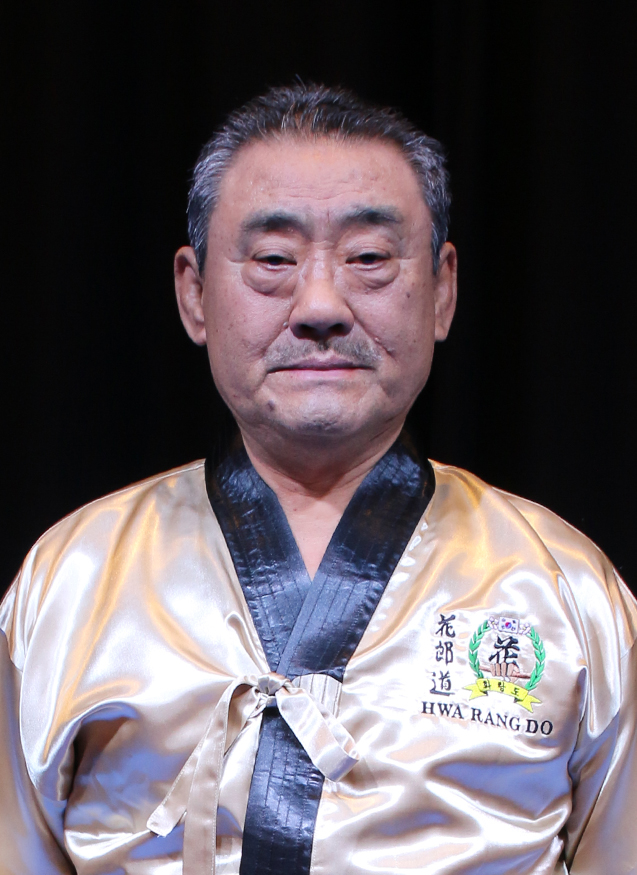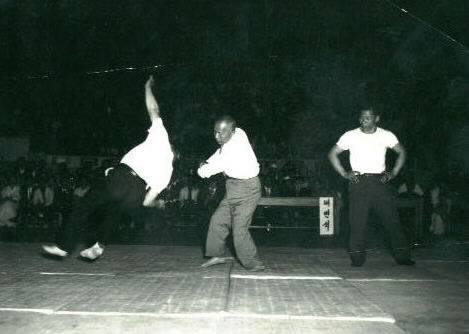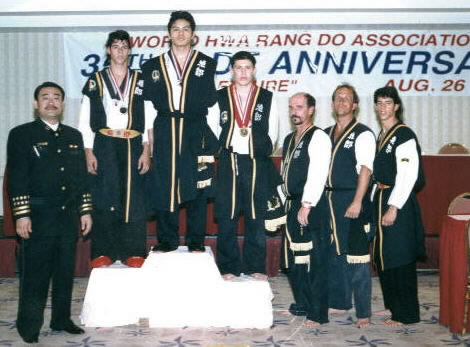HWA RANG DO® TAE SOO DO®


Founder Dr.Joo Bang Lee
Click Here to see WHRDA Timeline!
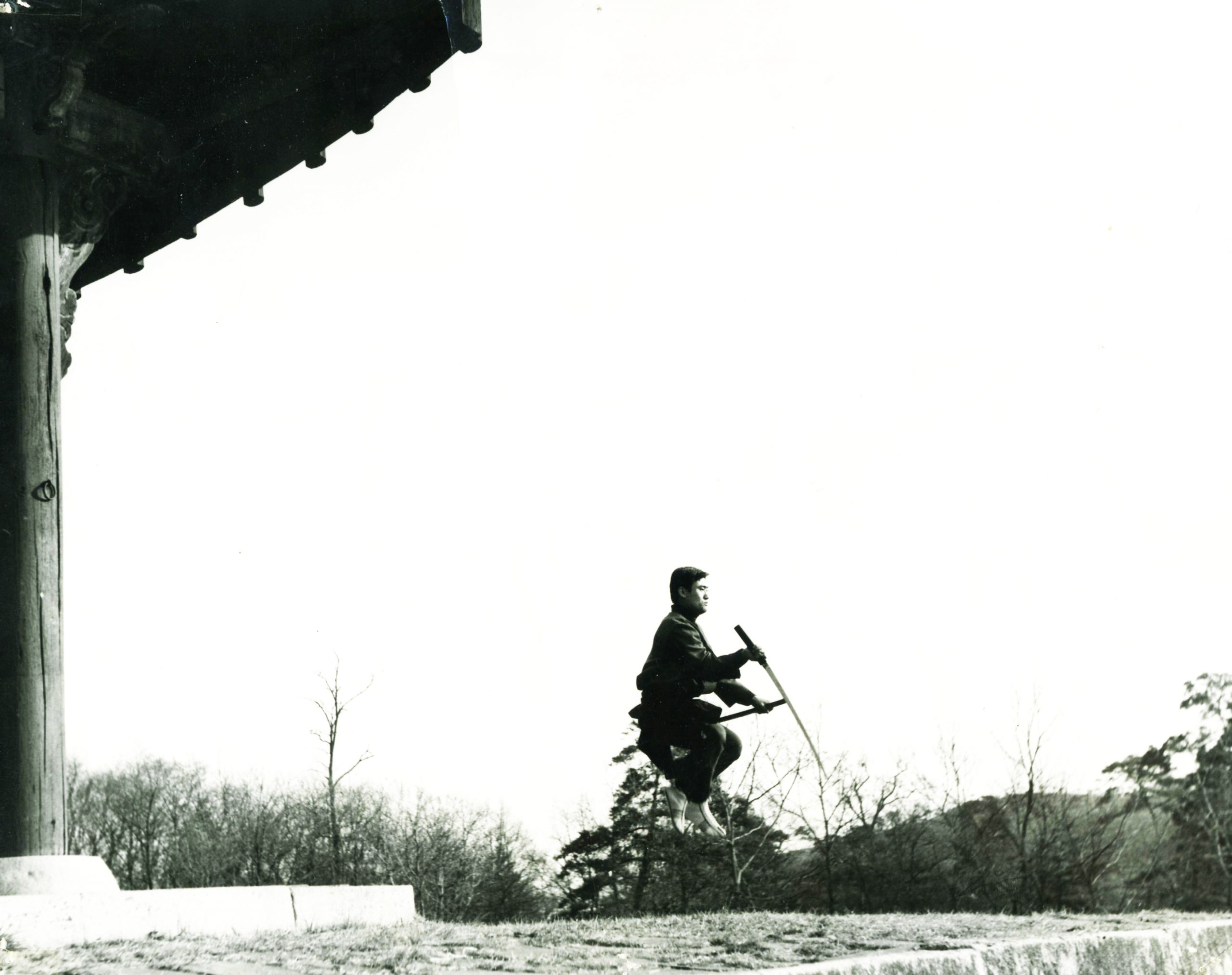
References to the Hwarang come to an end after the fall of the Koryo dynasty. In 1392 a Hwarang general (or Jang-gun 장군 將軍) named Sung-Kye Yi overthrew the Koryo Dynasty to establish the Yi Dynasty (also called the Choson Kingdom 조선 朝鮮). His son, King T'aejong Bang-Won Yi, fearing that the powerful Hwarang generals could bring an end to his own rule, initiated a policy that put all their personal soldiers under the control of the king. The growing influence of Confucianism was another factor in the decline of the predominantly Buddhist Hwarang. Buddhist lands and treasures were confiscated and some Hwarang generals sought refuge in the mountains along with the Buddhist monks.
For the next six centuries the ancient Hwarang combat skills and culture survived only in seclusion. The concepts and techniques associated with the Hwarang were passed secretly from generation to generation, from monk to monk, in the mountains of Korea. During this period the Hwarang combat skills were passed from one master to a single or few disciples. Once a student had truly mastered the Hwarang skills and culture, his master would pass on the Hwarang title to his student before he died. This means of transmission continued until that Hwarang title was passed to the monk Suahm Sonsa (수암선사 修岩禪師 - aka Suahm Dosa 도사 道師). He was the 57th generation Hwarang title-holder.
In the early 1940′s Suahm Dosa began teaching Dr. Joo-Bang Lee and his brother Joo-Sang Lee at the Sok-wang Sa Temple (석왕사 釋旺寺) in North Korea. These two brothers had initially begun their martial skills training under the direction of their father, who taught them from the time they were old enough to walk. Lee’s father, who was a personal friend of Suahm Dosa, later asked the master to train his young sons in the secret Hwarang combat skills of Um-Yang Kwon (음양권 陰陽拳), which was comprised of both soft and hard skills. These brothers thus began their training with Suahm Dosa at the ages of four and five. This was the beginning of a father-son relationship between the brothers and this monk that lasted for almost thirty years (1942-1969). No one else learned these secret Um-Yang Kwon skills other than our Founder and his brother. Just before his death in July of 1969, Suahm Dosa gave the 58th generation Hwarang warrior title to our Hwa Rang Do founder, Dr. Joo-Bang Lee.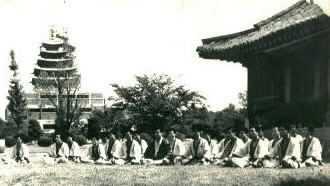
Our Founder’s mountain training schedule was rigorous. He and his brother would wake up at five o’clock in the morning, wash with icy cold water to clean their bodies and then warm up and practice for one hour. Then they cooked breakfast and served their master. Around eight o’clock, after they had done the dishes, they trained for three to four hours and then served lunch. At one o’clock they took a nap, and then at two o’clock they began training for another four hours. After serving dinner they studied healing skills (In Sool - 인술 仁術) and mental development (Shin Gong - 신공 神功). So every day they trained for eight or nine hours in the Um-Yang Kwon combat skills and for two to three hours they focused on healing skills and mental development.
After Korea gained its independence from the Japanese Occupation (1910-1945), the country was divided into two sections — the communist North and the democratic South. So in 1948 the Lee family escaped together with Suahm Dosa into the territory of South Korea. Lee’s family settled in Seoul, while Suahm Dosa moved to Yang Mi cottage (Yang Mi Am - 양미암 陽嵋庵), a hermitage near Woljeong temple (Woljeong-sa - 월정사 月精寺) on Odae Mountain. (Note about Yang Mi Am: Although Woljeong-sa is still an important religious site, Suahm Dosa’s private residence was burned after his death in accordance with religious custom and no longer exists today.)
When the Korean War broke out in the 1950's, the Lee family moved further south to Daegu, South Korea. It was there that the Lee brothers met Yong-Sul Choi (죄용술 崔龍述). Master Choi was the founder of Dae Dong Ryu YuSool (대동류유술), a name that reflects the Korean pronunciation of a Japanese system called Daito-Ryu Yawara (大東流柔術). Master Choi had learned this art during the Japanese occupation while serving as a house servant to Takeda Sogaku, the headmaster of the Daito-Ryu Yawara system. Since the Lee brothers no longer had access to their master Suahm Dosa, they began taking private lessons from Master Choi and received master positions in this art in 1956 before they moved back to Seoul.
In April 1960 Dr. Joo-Bang Lee and his brother Joo-Sang Lee opened their first school. At this point their master Suahm Dosa had not given them permission to teach the Hwarang skills to the public. He said that these combat skills were too dangerous to be taught to the public because they could be used to inflict great harm if people with evil intentions learned them. He instructed our Founder, Dr. Joo-Bang Lee, to become a doctor of eastern medicine and to only pass on these combat skills to his sons. Since our Founder was also trained as a master of YuSool, he followed the honorable way and began teaching YuSool under the under the name Hwarang Mu Sool (화랑무술 花郎武術).
In 1961 Dr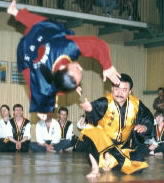 . Joo-Bang Lee began using the name Hapkido (합기도 合氣道) for his dojang. Founder Choi’s first masters did not want to continue using the YuSool (Yawara) name for their dojangs because the Korean public hated the use of Japanese terms. The Hapkido name was at least unknown and less offensive. The first person to use this name was another of Choi's students, Master Moon-Jin Kang. Master Kang had come across some printed reference to Aikido (合氣道 - meaning "way of harmonious energy"), a name that was being used in Japan by Morehei Uyeshiba who was another student of the Yawara tradition upon which YuSool was based, and thought that this name sounded appealing. So Master Kang began to use the name Hapkido (the Korean pronunciation of 合氣道) for the school which he opened in Daegu in 1959. About a year later Master Kang moved to Seoul to work for the DEA and Dr. Lee picked up the idea of this name from Master Kang. So Dr. Lee began using the name Hapkido for his dojang along with two other YuSool masters who also did the same. Master Han-Jae Ji changed the name of the dojang he originally opened in 1959 to Seongmu Kwan Hapkido (성무관합기도 聖武館合氣道 1961 – 1968 Seoul), and Master Mu Kim came from Daegu to Seoul and opened a dojang with the name of ShinMu Kwan Hapkido (신무관합기도 新武館合氣道 1961- 1970 Seoul). At this time these were the only schools in Seoul that were using this name. These are the three masters who are considered the founders of the Hapkido name.
. Joo-Bang Lee began using the name Hapkido (합기도 合氣道) for his dojang. Founder Choi’s first masters did not want to continue using the YuSool (Yawara) name for their dojangs because the Korean public hated the use of Japanese terms. The Hapkido name was at least unknown and less offensive. The first person to use this name was another of Choi's students, Master Moon-Jin Kang. Master Kang had come across some printed reference to Aikido (合氣道 - meaning "way of harmonious energy"), a name that was being used in Japan by Morehei Uyeshiba who was another student of the Yawara tradition upon which YuSool was based, and thought that this name sounded appealing. So Master Kang began to use the name Hapkido (the Korean pronunciation of 合氣道) for the school which he opened in Daegu in 1959. About a year later Master Kang moved to Seoul to work for the DEA and Dr. Lee picked up the idea of this name from Master Kang. So Dr. Lee began using the name Hapkido for his dojang along with two other YuSool masters who also did the same. Master Han-Jae Ji changed the name of the dojang he originally opened in 1959 to Seongmu Kwan Hapkido (성무관합기도 聖武館合氣道 1961 – 1968 Seoul), and Master Mu Kim came from Daegu to Seoul and opened a dojang with the name of ShinMu Kwan Hapkido (신무관합기도 新武館合氣道 1961- 1970 Seoul). At this time these were the only schools in Seoul that were using this name. These are the three masters who are considered the founders of the Hapkido name.
While these three masters are the founders of the Hapkido name, they were still teaching different skills in their dojangs. Han-Jae Ji and Mu Kim were teaching the same techniques they had learned from YuSool founder Yong-Sul Choi and adopted some soft style kicking combat skills. So their system had no forms, striking techniques, or weapons. At the same time our founder Dr. Joo-Bang Lee and his brother were teaching both Hwa Rang Do® and Hapkido. So there were two sets of martial skills being taught under the same martial art name despite the major differences between them.
In the winter of 1962 the Lee brother’s founded the first public Korean martial arts organization called the Kuk Sul Hwae (국술회 國術會) — short for Han-Guk Mu-Sul Hyup-Hwae (한국무술협회 韓國武術協會) or Korean Martial Skills Association — together with five other charter members, two in Seoul and three in Pusan. Of the original seven members, our founder and Master In-Hyuk Suh are the only ones still involved in martial arts. In-Hyuk Suh had become one of the members of the Kuk Sool Hwae while visiting Seoul in 1962. He moved back south immediately after the winter of 1962 and opened his first school in the city of Pusan with two other charter members. He left the Kuk Sool Hwae organization in 1965 and used his own name of Kuk Sool Won Hapkido (국술완합기도 國術院合氣道) for his YuSool and Chinese Ship P'al Gi (十八技, i.e., Kung-fu) skills. Today our founder now leads Hwa Rang Do® and In-Hyuk Suh uses the name Kuk Sool Won (without the Hapkido name), which means the "Korean Martial Skills House."
So after 1965, the Kuk Sool Hwae organization was divided into two parts. Our founder held the Kuk Sool Hwae (국술회 國術會) - Korean Martial Skills Association) national headquarters in Seoul and In-Hyuk Suh held the Kuk Sool Won Hapkido (국술완합기도 國術院合氣道 - Korean Martial Skills House of Hapkido) dojang in Pusan. There has been some public misunderstanding about these organization leaders and what they were teaching during this time. However, they were masters of different styles and even though attempts were made to unify a curriculum, they were also teaching completely different skills even though they were unified under the same Korean Martial Skills Association (Kuk Sool Hwae).
During this time our Founder had the best operation of the Kuk Sool Hwae in either the capital Seoul or the rest of the nation. Every year from 1962-1966 he promoted his Kuk Sool Hwae in the Jang Chung sports arena with an exposition and tournament. These were some of the biggest martial arts events of that time and were broadcasted on Korean national television. During this time all martial art practitioners knew that our founder Dr. Joo-Bang Lee and his brother founded the renowned Kuk Sool Hwae organization and the Hapkido name.
In 1963 the Korean Dae Dong Ryu YuSool founder Yong-Sul Choi and his first Masters (Joo-Bang Lee, Joo-Sang Lee, Woo-tack Kim, Han-Jae Ji, Bok-Sup Suh, Jeong-Yoon Kim, Kwang-Hwa Won) held a meeting at the HanPool school in Seoul. At this meeting there were dicussions to change the martial art names of YuSool and Hapkido to the new martial art name of Kido (기도 氣道). The reason for this change was that the art of Aikido (合氣道) established in 1943 by Morei Ueshiba, one of Takeda Sogaku's students in the Daito Ryu Yawara system, had become increasingly popular during the 1960′s in Japan. As a result the Hapkido (합기도 合氣道) name, which is the Korean pronunciation of the Japanese term Aikido (合氣道), was just as problematic for the Korean public as YuSool had once been. After this meeting Bok-Sup Suh and Doo-Yong Kim made a second organization of Korean martial arts called the Korean Kido Association (대한기도회 大韓氣道會) and registered it with the Korean government. However, this organization was based in the rural area of Daegu, South Korea and no one else joined the organization, and the Kido name did not stay (most masters continued under the Hapkido name). Over twenty years later, in the late 1980's, In Hyuk Suh took over the empty label of Kido identity and gave it to his brother In-Sun Seo. So this later Korean Kido Association is also one of In-Hyuk Suh’s organizations.
The following list identifies all of the martial art dojangs that were operating in Seoul in 1963.
1. Two Yudo schools:
- Yudo college
- Yudo Jungang dojang
2. Seven Hwa Rang Do® and Hapkido dojangs:
- Two Kuk Sool Hwae dojangs — Founder Dr. Joo-Bang Lee and Joo-Sang Lee’s dojang (1960 - present) and Woo Kim’s dojang (1962-1970) in Seoul, plus In-Hyuk Suh's dojang in Pusan (1963-present)
- Two Seongmu Kwan dojangs — one by Founder Han-Jae Ji opened 1959 originally with Yawara name and then changed to Seongmu Kwan (1962-1968), plus Yong-Jin Kim’s dojang (1962-1968)
- One Shinmu Kwan dojang — Founder Mu-Hong Kim (1961~1970)
- One Kwangmu Kwan dojang — Founders Dong-Gu Lee and Yong-Jin Cha (1963~1968)
- One Musool Kwan dojang — Founder Kwang-Hwa Won (1963~1972)
3. Six main hard-style dojangs:
- Songmu Kwan KongSooDo dojang — Founder Byung-Jik Ro (1953~1965)
- Ch'angmu Kwan KongSooDo dojang — Founder Nam-Suk Lee (1955~1965)
- Ch'ongdo Kwan KongSooDo dojang — Founder Won-Kuk Lee (1953~1965)
- Jido Kwan KongSooDo dojang — Founder Jeong-Woo Lee (1956~1965)
- Muduk Kwan TangSooDo dojang — Founder Ki Hwang (1953~1965)
- Ohdo Kwan Taekwondo (from the military) — Founder Hong-Hee Choi (1958~1965)
So the martial arts that Korea had after the independence from Japan are Gumdo (Kendo), Yudo (Judo), Kongsoodo (Karatedo), Tangsoodo (Karatedo), YuSool (Daito Ryu Yawara or Aiki Jujitsu which came to Korea in 1945 but was publically founded in 1953). Then there are the three martial arts that became the base of the new Korean traditional combat skills, Hwa Rang Do® (founded 1960), Hapkido (the new form of Daedong Ryu YuSool descended from Daito Ryu Yawara - founded 1961), and Taekwondo (founded when KongSooDo, TangSooDo or SooBakDo, and Taekwondo unified in 1965).
In 1967 the Korean president Jeong-Hee Park became interested in our Founder's Kuk Sool Hwae. So the chief of the secret agents, Jong-Kyu Park sent master Han-Jae Ji (who was teaching the secret agents of the Korean Blue House) to meet with our founder Dr. Lee at his headquarters in Seoul. There they discussed the President’s request to unify the Korean martial arts under one name and governing organization like what had happened in 1965 when Kong Soo Do (SongMu Kwan, Ch'ongDo Kwan, Ch'angMu Kwan, JiDo Kwan, HanMu Kwan), Tang Soo Do (MuDuk Kwan), and Tae Kwon Do (military OhDo Kwan) unified as a Korean martial sport under the name Tae Kwon Do and the one governing organization of the Korean Tae Kwon Do Association. So, Grandmaster Lee and Grandmaster Ji banded together to try and unify the Korean martial arts. At this time our Founder disbanded his Kuk Sool Hwae organization and began to focus on this new task.
At the request of President Park, our Founder Dr. Joo-Bang Lee and his brother Joo-Sang Lee organized the Korean Martial Arts Association (Daehan Mudo Hwae, 대한무도회 大韓武道會) together with SeongMu Kwan Hapkido founder Han-Jae Ji, Kihapdo founder Dae-Hoon Choi (who held a high position in the KCIA), Jong-Kyu Park (the chief secret agent), and Ji-Chul Cha (a congressman who later became the chief secret agent and was assassinated with President Park). Dae-Hoon Choi became president of the Association, Jong- Kyu Park became the chairman, and there were many government administrators and congressman that were board members. Our founder Dr. Lee, his brother, and other Hwa Rang Do masters directed the unification of all the Korean martial arts and promotions, while other martial art founders supported their efforts.
On May 27, 1968 the National Unified Korean Martial Arts Exposition was held at the Jang Chung Sports Arena in Seoul under promotion of our founder Dr. Lee and his brother. The martial arts that were included in this exhibition of unification were:
• Hwa Rang Do (화랑도 花郎道)
• Bi Sool (비술 秘術)
• Kido (기도 氣道)
• Ki Hap Do (기합도 氣合道)
• Kuk Ki Do (국기도 國氣道)
• Kuk Sul Kwan Hapkido (국술관합기도 國術館合氣道)
• Seong Mu Kwan Hapkido (성무관합기도 聖武館合氣道)
• Shin Mu Kwan Hapkido (신무관합기도 新武館合氣道)
• Yu Sool (유술 柔術)
• Yu Kwon Sul (유관술 柔拳術)
Presently all of these other martial art names have been disbanded and are no longer used in the public except for Hwa Rang Do® and Hapkido.
At the time of this unified martial arts exposition, Grandmaster Yong-Sul Choi who was the founder of YuSool officially changed the name of his art to Hapkido. At this time his title became Hapkido Dojoonim (the owner of Hapkido) and he no longer used the YuSool name. Also at this event in 1968, Grandmaster Choi conferred upon our Founder Dr. Joo-Bang Lee and Han-Jae Ji the rank of Grandmaster, 8th Dan Degree Black Belt, the highest position in Hapkido.
Unfortunately, the Daehan Mudo Hwae (Korean Martial Art Association) disbanded shortly after the unified martial arts exposition. One of the Hapkido officers began selling the rights to hundreds of dojang licenses and high ranking black-belt certificates, making it impossible to regulate and control the quality of the art. The Lee brothers knew they were could not represent Hapkido if the ethos of the art was going to disintegrate in this fashion. Unable to find a solution, Joo-Bang Lee went to his master Suahm Dosa and explained the circumstances that had transpired over the past eight years. After recounting these events, Dr. Lee finally received permission from Suahm Dosa to teach the ancient Hwarang combat skills to the public. As a result, the Daehan Mudo Hwae (Korean Martial Art Association) disbanded. Dae-Hoon Choi and Han-Jae Ji continued to promote Hapkido under the auspices of the Korean Hapkido Association (Daehan Hapkido Hyop Hwae - 대한합기도협회 大韓合氣道協會). Dr. Joo-Bang Lee and his brother, Joo-Sang Lee, created HWA RANG DO® (화랑도 花郎道 - “The Way of the Flowering Manhood”) and the Korean Hwa Rang Do® Association (Daehan Hwarangdo Hwae - 대한화랑도회 大韓花郎道會).
In 1968 the Lee brothers combined the spirit and philosophy of the ancient Hwarang together with the secret combat skills that had been transmitted to them by Suahm Dosa. Since Dr. Joo-Bang Lee and his brother had been taught all the skills of the combat system without any ranking system, our Founder created and divided all of the skills that he had learned into his Hwa Rang Do syllabus for the public. From this point on he concentrated his efforts exclusively on the development of Hwa Rang Do.
In 1968 our Founder's brother, Head Grandmaster Joo-Sang Lee, also introduced the martial art of Hwa Rang Do to the United States of America. Recognizing that the United States would be a strategic location for promoting Hwa Rang Do to the rest of the world, our Founder Dr. Joo-Bang Lee immigrated to America in 1972. Here he established the sole international governing agency of Hwa Rang Do, the WORLD HWA RANG DO® ASSOCIATION, which currently operates from the Hwa Rang Do World Headquarters in Tustin, California.
In 1990, Founder Dr. Joo-Bang Lee developed an undergraduate martial sport program for the martial art Hwa Rang Do and named it TAE SOO DO® (태수도 太手道). This name, which literally means the 'Way of the Great Hand', is metaphorically translated as the 'Way of the Warrior Spirit'. This martial sport program was added because Hwa Rang Do training is very complicated and difficult. Individuals must first develop a strong foundation of martial skills and attitude before they are ready to effectively pursue Hwa Rang Do training. Since the traditional syllabus of Hwa Rang Do established in 1960 could not be changed, Tae Soo Do was created as a means of presenting aspects of Hwa Rang Do as a form of recreation and self-defense to the vast majority of people who were not experienced in martial arts. The goal was to develop strong fundamentals of a complete martial artist from striking, grappling, and weaponry. After these practitioners receive a Tae Soo Do black belt, they can receive a Hwa Rang Do Yellow Sash and continue training in the main art of Hwa Rang Do.
When Founder Dr. Joo-Bang Lee created Hwa Rang Do® as a public martial art identity, he divided our Hwa Rang Do curriculum into the dichotomies of Musool (무술 武術 - martial skills) and Insool (인술 仁術 - healing skills). If one has the ability to cause injury or take a life, then he or she must also have the ability to heal and preserve life. Founder Dr. Lee is a licensed doctor of eastern medicine and an acupuncture specialist and Ki healer. He learned secret techniques from his master Suahm Dosa’s healing skills, graduated from DongYang University of Eastern Medicine in Korea, and received his Ph D. from SamRa University of oriental medicine. He insists that all advanced practitioners of Hwa Rang Do learn the healing arts as well as the combative aspects.
Founder Dr. Joo-Bang Lee is the one who divided and created the categories of Hwa Rang Do® for public instruction. The martial art skills (or Musool) are divided into four categories: Nae Gong (內功 - internal training), Wae Gong (外功 - external power training), Mugi Gong (武技功 or 武器功 - weapon training), and Shin Gong (神功 - mental training). He also divided the healing aspects or (In-sool) into the six categories of Ji Ap Sool (指壓術 - acupressure), Ch'im Gu Sool (針灸術 - acupuncture and moxibustion), Yak Bang Bop (藥方法 - herbal medicine), Jup Gol Sool (接骨術 - bone setting), Hwal Bop (活法 - Special Aids), and Ki Ryuk Sool (氣力術 - Ki-power healing).
Our founder also teaches the ancient Hwarang code of ethics and his own philosophies concerning human morality. These concepts are embodied in the ancient Hwarang O Kae ("Five Rules of the Hwarang") (insert link to Wonkwang Bopsa story) and in our Founder's Hwarang Kyo Hoon ("Hwarang Code of Ethics").
HWARANG O KAE (花郎五戒)
(The five rules of the ancient Hwarang)
1. SA GUN E CHOONG – 사 군이충 事君以忠
LOYALTY TO ONE`S KING AND COUNTRY.
2. SA CHIN E HYO – 사친이효 事親以孝
LOYALTY TO ONE`S PARENTS AND TEACHERS.
3. KYO WOO E SHIN – 교우이신 交友以信
TRUST AND BROTHERHOOD AMONG FRIENDS.
4. IM JEON MU TWAE – 임전무퇴 臨戰無退
COURAGE NEVER TO RETREAT IN THE FACE OF THE ENEMY.
5. SAL SENG YOO TECH – 살생유택 殺生有擇
JUSTICE NEVER TO TAKE A LIFE WITHOUT A CAUSE.
HWA RANG DO® KYOHOON (花郎道教誨)
(Our Founder’s nine teaching moralities)
1. IN 인 仁
HUMANITY
2. UEI 의 義
JUSTICE
3. YAE 예 禮
COURTESY
4. JI 지 智
WISDOM
5. SHIN 신 信
TRUST
6. SUN 선 善
GOODNESS
7. DUK 덕 德
VIRTUE
8. CHOONG 충 忠
LOYALTY
9.YONG 용 勇
COURAGE
In order to maintain its historic identity, our Founder has established Hwa Rang Do® as an international trademark. He has also secured a copyright registration that encompasses all techniques, the syllabus, uniforms, its name, and all other aspects of our art. Hwa Rang Do® is thus protected by international and federal laws. Because our founder created this martial art from the Um-Yang Kwon skills of his master, the name Um-Yang Kwon® also falls under this trademark protection and cannot be used without authorization. The registration of Hwa Rang Do® has been done in order to protect and ensure the quality of this martial art for the sake of future generations.
Our Founder has also demonstrated by his actions and teaching the importance of loyalty to a single martial art identity. Although individual Hwa Rang Do instructors may have once trained in other systems, they no longer do so and no longer lay claim to those ranks. In this manner they follow the example of our Founder who relinquished his founding position in Hapkido in order to dedicate all his efforts to the promotion of the ancient skills taught to him by Suahm Dosa. As a result, all the Hwa Rang Do academies and clubs throughout the world teach the same curriculum passed down to them from their founder. This Hwa Rang Do identity is also why the World Hwa Rang Do Association never gives permission to use the terms Kwan (관 館), Won (원 院) or any personal name in connection with Hwa Rang Do.
Our Founder also ensures the ongoing legacy of Hwa Rang Do by requiring that all Hwa Rang Do® practitioners receive their Dan degrees directly from the one and only source of this martial art, Founder Dr. Joo-Bang Lee. Wherever you go in the world, you can be assured that certified Hwa Rang Do instructors are not promoting themselves with ranks or titles they have not earned. Through the efforts of the World Hwa Rang Do® Association and the policies it has created, the martial art identity of Hwa Rang Do® will be able to maintain its integrity and we can be proud of our true ranks.
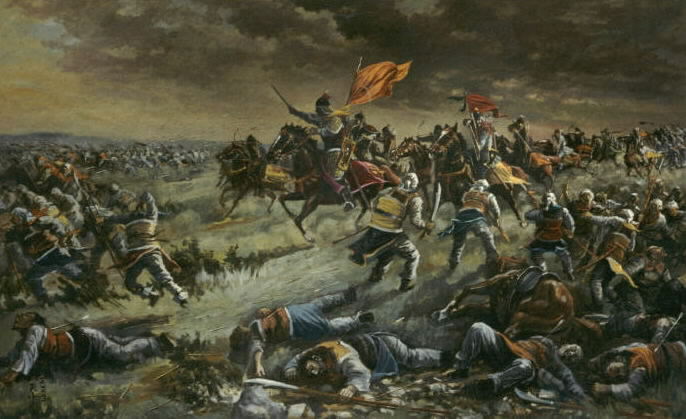 Chivalry endured throughout the Silla (B.C.57) and Koryo (A.D.938) dynasties and was the driving force that unified the Korean peninsula and formed the basis for the modern state of Korea. In 1392, a Hwarang Jang Gun (General),named Sung-Kae Yi (or Lee) overthrew the Koryo Dynasty and established the Yi Dynasty which was called ChoSun. The third king of this dynasty, King TaeJong Bang-Won Lee (the 5th son of TaeJo Sung-Kae Lee), implemented many changes within the kingdom. One of these changes was he initiated a policy which put all of the Hwarang
Chivalry endured throughout the Silla (B.C.57) and Koryo (A.D.938) dynasties and was the driving force that unified the Korean peninsula and formed the basis for the modern state of Korea. In 1392, a Hwarang Jang Gun (General),named Sung-Kae Yi (or Lee) overthrew the Koryo Dynasty and established the Yi Dynasty which was called ChoSun. The third king of this dynasty, King TaeJong Bang-Won Lee (the 5th son of TaeJo Sung-Kae Lee), implemented many changes within the kingdom. One of these changes was he initiated a policy which put all of the Hwarang ![]() Jang Gun's (Japanese-Sho Gun) personal soldiers (rangdo
Jang Gun's (Japanese-Sho Gun) personal soldiers (rangdo ![]() ) under his, the king's control. King TaeJong was afraid that other strong Jang Guns would attack his dynasty. So he initiated this policy that strengthened his own power, and at the same time greatly reduced the power of all other Jang Guns. Another impactful fact of this time was that the prevailing religion of the country was Confucianism.These are the two main factors that forced many Buddhist monks and some Hwarang Jang Gun`s to seek refuge in the mountains.And because of this, the Hwarangdos (Groups of Hwarang)
) under his, the king's control. King TaeJong was afraid that other strong Jang Guns would attack his dynasty. So he initiated this policy that strengthened his own power, and at the same time greatly reduced the power of all other Jang Guns. Another impactful fact of this time was that the prevailing religion of the country was Confucianism.These are the two main factors that forced many Buddhist monks and some Hwarang Jang Gun`s to seek refuge in the mountains.And because of this, the Hwarangdos (Groups of Hwarang) ![]() system, which was also called the Kuksundos (Groups of Kuksun)
system, which was also called the Kuksundos (Groups of Kuksun) ![]() and Pungwouldos (Groups of Pungwoul)
and Pungwouldos (Groups of Pungwoul)![]() system during the Koryo dynasty, disappeared from the public. It was almost a 600 year period that the ancient Silla Hwarang combat skills and its culture lived apart from society. During this Yi dynasty, the concepts and techniques of this Hwarang title were passed secretly generation to generation from monk to monk in the mountains of Korea. This was a unique period for the Hwarang combat skills because they were passed from only one master to one disciple. Also, along with passing on these combat vskills, the Hwarang title was passed from master to student during this period. If the student had truly mastered this entire culture, the master would give the Hwarang title to the student before he died. This way of transmission lasted until the tradition was passed to the monk Suahm Sunsa
system during the Koryo dynasty, disappeared from the public. It was almost a 600 year period that the ancient Silla Hwarang combat skills and its culture lived apart from society. During this Yi dynasty, the concepts and techniques of this Hwarang title were passed secretly generation to generation from monk to monk in the mountains of Korea. This was a unique period for the Hwarang combat skills because they were passed from only one master to one disciple. Also, along with passing on these combat vskills, the Hwarang title was passed from master to student during this period. If the student had truly mastered this entire culture, the master would give the Hwarang title to the student before he died. This way of transmission lasted until the tradition was passed to the monk Suahm Sunsa ![]() (aka Suahm Dosa
(aka Suahm Dosa ![]() ). He was the 57th generation Hwarang title-holder.
). He was the 57th generation Hwarang title-holder.
In the early 1940's Suahm Dosa began teaching his only two disciples at the So Gwang Sa Temple in North Korea. These lone disciples were Dr. Joo-Bang Lee and his brother Joo-Sang Lee. The two brothers began their martial skills study under the direction of their father who taught them his martial art skills from the time they were old enough to walk.Later Lee's father, who was a personal friend of Suahm Dosa, asked the master to train his sons in his secret ancient Hwarang combat skills "Um Yang Kwon" ![]() (soft and hard skills). These brothers began their training with Suahm Dosa at the ages of 4 and 5. This was the beginning of a father and son relationship between the brothers and the monk, which lasted for almost 30 years, from 1942-1969 until Suahm Dosa passed away. Then in July of 1969 before Suahm Dosa passed away, he gave the 58th generation Hwarang warrior title to our Hwa Rang Do® founder Dr. Joo-Bang Lee. Nobody else learned these secret Um Yang Kwon combat skills other than our Founder. So the name of these techniques (Um Yang Kwon) are considered the same as the Hwa Rang Do® name. This is because our founder is the only one who trained in these skills and then created the martial art identity Hwa Rang Do®. That is also why the Um Yang Kwon name falls under the protection of the Hwa Rang Do® trademark and cannot be stolen or used by anyone else.
(soft and hard skills). These brothers began their training with Suahm Dosa at the ages of 4 and 5. This was the beginning of a father and son relationship between the brothers and the monk, which lasted for almost 30 years, from 1942-1969 until Suahm Dosa passed away. Then in July of 1969 before Suahm Dosa passed away, he gave the 58th generation Hwarang warrior title to our Hwa Rang Do® founder Dr. Joo-Bang Lee. Nobody else learned these secret Um Yang Kwon combat skills other than our Founder. So the name of these techniques (Um Yang Kwon) are considered the same as the Hwa Rang Do® name. This is because our founder is the only one who trained in these skills and then created the martial art identity Hwa Rang Do®. That is also why the Um Yang Kwon name falls under the protection of the Hwa Rang Do® trademark and cannot be stolen or used by anyone else.
Our founder's mountain training schedule was; wake up at 5 o'clock in the morning and with icy cold water clean their body and then warm up and practice for one hour. Then they cooked breakfast and served their master. Around 8 o'clock, after they did the dishes, they trained for three to four hours and then served lunch. At one o'clock they took a nap, and at 2 o'clock they trained for another four hours. After serving dinner they studied Shin Gong (mental power) and In Sool (healing skills). So everyday they trained 8-9 hours of Um Yang Kwon combat skills ![]()
![]() and 2-3 hours of In Sool
and 2-3 hours of In Sool ![]() and Shin Gong
and Shin Gong ![]() training.
training.
After the 1945 Korean Independence from the Japanese Occupation (1910-1945), Korea
was divided into 2 sections, North (communist) and South (democratic). So in 1948, Lee`s family and Suahm Dosa escaped the north to South Korea. Lee's family landed in Seoul, and Suahm Dosa moved to O Dae Mountain and the Yang Mi Ahm ![]() sanctuary. This sanctuary was only Suahm Dosa's living quarters in the mountain,and no other monks lived there. After Suahm Dosa passed away Dr. Joo-Bang Lee followed the religious tradition of his master and burned this living quarters, so it does not exist anymore. Later, during the 1950's, the Korean War broke out and the Lee family moved further south to DaeGu, Korea. It wasthen that the Lee brothers met the DaeDongRyu YuSool
sanctuary. This sanctuary was only Suahm Dosa's living quarters in the mountain,and no other monks lived there. After Suahm Dosa passed away Dr. Joo-Bang Lee followed the religious tradition of his master and burned this living quarters, so it does not exist anymore. Later, during the 1950's, the Korean War broke out and the Lee family moved further south to DaeGu, Korea. It wasthen that the Lee brothers met the DaeDongRyu YuSool ![]() founder Yong-Sul Choi. The Lee brothers took private lessons from Master Choi and received master position of this art in 1956. After this they moved backto Seoul.
founder Yong-Sul Choi. The Lee brothers took private lessons from Master Choi and received master position of this art in 1956. After this they moved backto Seoul.
April 1960, Dr. Joo-Bang Lee and his brother Joo-Sang Lee created and founded their martial art system and opened their first school. They combined the spirit and philosophy of the Ancient Silla Hwarang warriors with the secret combat skills knowledge that was passed to them from Suahm Dosa. The name of this new martial art identity they founded is HWA RANG DO® ![]() . This is translated as "The Way of the Flowering Manhood," the suffix "Do"
. This is translated as "The Way of the Flowering Manhood," the suffix "Do" ![]() used in this term represents "the way" or "the martial art." This "Do" has a different meaning than the "Do"
used in this term represents "the way" or "the martial art." This "Do" has a different meaning than the "Do"![]() that is used in connection with the ancient Silla Hwarang Youth Groups. These ancient youth groups was made up of Hwarang
that is used in connection with the ancient Silla Hwarang Youth Groups. These ancient youth groups was made up of Hwarang ![]() leaders and Rangdo
leaders and Rangdo ![]() disciples, and together as a group they were called Hwarangdo
disciples, and together as a group they were called Hwarangdo ![]() (meaning a group of Hwarang and Rangdo). The meaning of the "Do"
(meaning a group of Hwarang and Rangdo). The meaning of the "Do" ![]() term used here is a group of people. Please keep in mind this difference,because the martial art Hwa Rang Do®
term used here is a group of people. Please keep in mind this difference,because the martial art Hwa Rang Do® ![]() and the ancient Silla Hwarangdo
and the ancient Silla Hwarangdo ![]() youth groups are not the same identities.
youth groups are not the same identities.
During their mountain training with Suahm Dosa, Dr. Joo-Bang Lee and his brother did not learn from a Belt by Belt syllabus. They were taught all the skills of the combat system without any ranking system. So our Founder created and divided all of the skills that he had learned, into his Hwarang Do® syllabus for the public. So this martial art name Hwa Rang Do® contains his ancient Hwarang combat skills and his human morality philosophies.
However, in 1960 their master Suahm Dosa did not give them permission to teach the Hwarang skills to the public. Their master Suahm Dosa said that these combat skills were too dangerous to be taught to the public because they would inflict great harm if people with evil minds learned them. So he told our founder Dr. Joo-Bang Lee to be a doctor of eastern medicine for his profession, and only pass on these combat skills to his sons.
 Since our Founder had already opened a school, had a strong mentality for teaching his students the honorable way, and was secondly a trained master of YuSool
Since our Founder had already opened a school, had a strong mentality for teaching his students the honorable way, and was secondly a trained master of YuSool ![]() , he began to temporarily use the new name Hapkido
, he began to temporarily use the new name Hapkido ![]() while teaching his Hwa Rang Do® skills. He and his other Yusool friends founded this new martial art name Hapkido in 1961. Originally in 1959 one of his friends, Master Moon Kang opened a school in Daegu with the name Hapkido for the first time. However, 6 months later master Choi ordered that the school be closed down because he did not want the YuSool name to be switched to the Hapkido name. Master Kang then moved to Seoul to work for the DEA and Dr. Lee got the idea of this new martial art name Hapkido from master Kang. Also in 1961, YuSool masters Han-Jae Ji and Mu Kim began using this new Hapkido name as well. Because of the circumstances surrounding the Japanese Occupation, the Korean public hated to use Japanese language during this time. So Master Choi's first masters did not want to use the Yawara
while teaching his Hwa Rang Do® skills. He and his other Yusool friends founded this new martial art name Hapkido in 1961. Originally in 1959 one of his friends, Master Moon Kang opened a school in Daegu with the name Hapkido for the first time. However, 6 months later master Choi ordered that the school be closed down because he did not want the YuSool name to be switched to the Hapkido name. Master Kang then moved to Seoul to work for the DEA and Dr. Lee got the idea of this new martial art name Hapkido from master Kang. Also in 1961, YuSool masters Han-Jae Ji and Mu Kim began using this new Hapkido name as well. Because of the circumstances surrounding the Japanese Occupation, the Korean public hated to use Japanese language during this time. So Master Choi's first masters did not want to use the Yawara ![]() (YuSool) name for their dojangs.
(YuSool) name for their dojangs.
So at the same time Dr. Lee began using the new martial art name Hapkido ![]() for his dojang that contained his Hwa Rang Do® skills, master Han-Jae Ji changed the name of his Yawara (YuSool) dojang which originally opened in 1959 to Seongmu Kwan Hapkido (1961 - 1968 Seoul)
for his dojang that contained his Hwa Rang Do® skills, master Han-Jae Ji changed the name of his Yawara (YuSool) dojang which originally opened in 1959 to Seongmu Kwan Hapkido (1961 - 1968 Seoul) ![]() , and master Mu Kim came from Daegu to Seoul and opened a dojang with the name of ShinMu Kwan Hapkido (1961- 1970 Seoul)
, and master Mu Kim came from Daegu to Seoul and opened a dojang with the name of ShinMu Kwan Hapkido (1961- 1970 Seoul) ![]() . At this time, these were the only schools in Seoul that were using this name,
. At this time, these were the only schools in Seoul that were using this name,
and these are the three masters who can be considered the founders of the Hapkido name.
While these three masters are the founders of this Hapkido name, they were still teaching different skills in their dojangs. Han-Jae Ji and Mu Kim were teaching the same techniques they had learned from YuSool founder Yong-Sul Choi and adopted some soft style kicking combat skills. So their system had no forms, striking techniques, or weapons. This is while our founder Dr. Joo-Bang Lee and his brother were teaching both HwaRangDo® and Hapkido. So there were two sets of martial skills being taught under the same martial art name, that had major differences between them.
In winter of 1962, the Lee brother's founded the first public Korean martial arts organization named the Korean Martial Skills Association (HanKuk MuSool HyupHwae ![]() - short name Kuk Sool Hwae
- short name Kuk Sool Hwae ![]() ). This was done with five other charter members. But there were only two schools in Seoul that were originally a part of this organization. These were our founder's school and Woo Kim's school. (Woo Kim had a school from 1962-1970, and in 1965 he left the Kuk Sool Hwae organization and changed the name of his school to KookSool Kwan Hapkido
). This was done with five other charter members. But there were only two schools in Seoul that were originally a part of this organization. These were our founder's school and Woo Kim's school. (Woo Kim had a school from 1962-1970, and in 1965 he left the Kuk Sool Hwae organization and changed the name of his school to KookSool Kwan Hapkido ![]() ). In-Hyuk Suh became one of the members of the Kuk Sool Hwae while visiting Seoul in 1962. He moved back south immediately after in the winter of 1962 and opened his first school in the city of Pusan with two other charter members. Later in 1965, he left the Kuk Sool Hwae organization and used his own name of KukSool Won Hapkido
). In-Hyuk Suh became one of the members of the Kuk Sool Hwae while visiting Seoul in 1962. He moved back south immediately after in the winter of 1962 and opened his first school in the city of Pusan with two other charter members. Later in 1965, he left the Kuk Sool Hwae organization and used his own name of KukSool Won Hapkido ![]() for his Yusool
for his Yusool ![]() and Chinese ShipPal Gi
and Chinese ShipPal Gi ![]() skills. From the original 7 charter members, our founder and Master In-Hyuk Suh are the only ones left that are still involved with martial arts. Our founder leads Hwa Rang Do®
skills. From the original 7 charter members, our founder and Master In-Hyuk Suh are the only ones left that are still involved with martial arts. Our founder leads Hwa Rang Do® ![]() and In-Hyuk Suh uses the name KukSool Won
and In-Hyuk Suh uses the name KukSool Won ![]() without the Hapkido name, which means Korean Martial Skills House.
without the Hapkido name, which means Korean Martial Skills House.
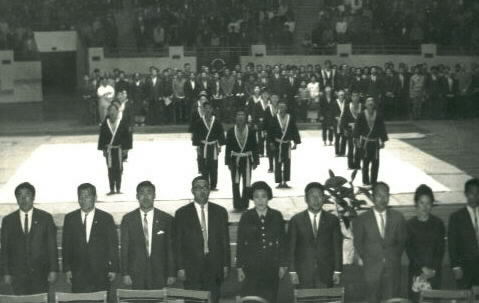 So after 1965, the Kuk Sool Hwae
So after 1965, the Kuk Sool Hwae ![]() organization was divided into parts. Our founder held the Kuk Sool Hwae (Korean Martial Skills Association)
organization was divided into parts. Our founder held the Kuk Sool Hwae (Korean Martial Skills Association) ![]() national headquarters in Seoul and In-Hyuk Suh held the Kuk Sool Won Hapkido (Korean Martial Skills House of Hapkido) dojang
national headquarters in Seoul and In-Hyuk Suh held the Kuk Sool Won Hapkido (Korean Martial Skills House of Hapkido) dojang ![]() in Pusan. There has been some public misunderstanding about these organization leaders and what they were teaching during this time. However, these masters were masters of different styles and were teaching completely different skills even though they were unified under the same organization name of the Korean Martial Skills Association
in Pusan. There has been some public misunderstanding about these organization leaders and what they were teaching during this time. However, these masters were masters of different styles and were teaching completely different skills even though they were unified under the same organization name of the Korean Martial Skills Association ![]() , (the Kuk Sool Hwae
, (the Kuk Sool Hwae ![]() ).
).
During this time period our Founder had the best operation of the Kuk Sool Hwae ![]() name in the capital of Seoul as well as the rest of the nation. Every year from 1962-1966 he promoted his Kuk Sool Hwae in the Jang Chung sports arena with an exposition and tournament. These were some of the biggest events of the martial arts society during this time, and were broadcasted on Korean national television. So during this time all martial art practitioners mostly know that our founder Dr. Joo-Bang Lee and his brother founded the renowned Kuk Sool Hwae organization and the Hapkido name.
name in the capital of Seoul as well as the rest of the nation. Every year from 1962-1966 he promoted his Kuk Sool Hwae in the Jang Chung sports arena with an exposition and tournament. These were some of the biggest events of the martial arts society during this time, and were broadcasted on Korean national television. So during this time all martial art practitioners mostly know that our founder Dr. Joo-Bang Lee and his brother founded the renowned Kuk Sool Hwae organization and the Hapkido name.
In 1963 the Korean DaeDongRyu YuSool ![]() founder Yong-Sul Choi and his first Masters (Joo-Bang Lee, Joo-Sang Lee, Woo-tack Kim, Han-Jae Ji, Bok-Sup Suh, Jeong-Yoon Kim, Kwang-Hwa Won) held a meeting at the HanPool school in Seoul. At this meeting they decided to change the martial art names of YuSool
founder Yong-Sul Choi and his first Masters (Joo-Bang Lee, Joo-Sang Lee, Woo-tack Kim, Han-Jae Ji, Bok-Sup Suh, Jeong-Yoon Kim, Kwang-Hwa Won) held a meeting at the HanPool school in Seoul. At this meeting they decided to change the martial art names of YuSool ![]() and Hapkido
and Hapkido ![]() to the new martial art name of "Kido"
to the new martial art name of "Kido"![]() . The reason for this change is because one of Dakete Shokaku's students of DaitoRyu Yawara, Morei Ueshiba, founded an art in 1943, which became popular during the 60's in Japan, with the name of Aikido
. The reason for this change is because one of Dakete Shokaku's students of DaitoRyu Yawara, Morei Ueshiba, founded an art in 1943, which became popular during the 60's in Japan, with the name of Aikido ![]() .This is the same name as Hapkido
.This is the same name as Hapkido ![]() , and the only difference is the pronunciation. After this meeting Bok-Sup Suh and Doo-Yong Kim made a second organization of Korean martial arts and registered with the Korean government the name of the Korean Kido Association
, and the only difference is the pronunciation. After this meeting Bok-Sup Suh and Doo-Yong Kim made a second organization of Korean martial arts and registered with the Korean government the name of the Korean Kido Association ![]() . However, this organization was based in the rural area of DaeGu Korean so nobody joined this organization, and it was not operational. However, over 20 years later, in the late 1980`s, In Hyuk Suh took over this empty organization and gave it to his brother InSun Seo. So this Korean Kido association is also one of In-Hyuk Suh's other organizations.
. However, this organization was based in the rural area of DaeGu Korean so nobody joined this organization, and it was not operational. However, over 20 years later, in the late 1980`s, In Hyuk Suh took over this empty organization and gave it to his brother InSun Seo. So this Korean Kido association is also one of In-Hyuk Suh's other organizations.
Here is a list of all of the martial art dojangs in Seoul at this time of 1963.
1. There were two Yudo schools - Yudo college and Yudo Jungang dojang.
2. Seven HwaRangDo® and HapKiDo dojangs - Two Kuk Sool Hwae dojangs in Seoul and one in Busan, one, Founder Dr. Joo-Bang Lee and Joo-Sang Lee's dojang 1960~present; plus Woo Kim's dojang 1962~1970; two Seongmu Kwan dojangs, one, Founder Han-Jae Ji 1961~1968, plus Yong-Jin Kim's dojang 1962~1968; one Shinmu Kwan dojang, Founder Mu-Hong Kim 1961~1970; one Kwangmu Kwan dojang, Founder Dong-Gu Lee and Yong-Jin Cha 1963~1968; one Musool Kwan dojang, Founder Kwang-Hwa Won 1963~1972.3.
The remaining 6 main hard style dojangs were:- Songmu Kwan KongSooDo dojang, Founder Byung-Jik Ro 1953~1965; Changmu Kwan KongSooDo dojang, Founder Nam-Suk Lee 1955~1965; Chongdo Kwan KongSooDo dojang, Founder Won-Kuk Lee 1953~1965; Jido Kwan KongSooDo dojang, Founder Jeong-Woo Lee 1956~1965,- Muduk Kwan TangSooDo dojang, Founder Ki Hwang 1953~1965,- Ohdo Kwan Taekwondo from the military, Founder Hong-Hee Choi 1958~1965.
So the martial arts that Korea already had after the independence from Japan are Gumdo(kendo), Yudo (Judo), Kongsoodo (Karatedo), Tangsoodo (Karatedo), Yusool (Daito Ryu Yawara or Aiki Jujitsu which came to Korea in 1945 but was publically founded in 1953). Then there are the three martial arts that became the base of the new Korean traditional combat skills, Hwa Rang Do® (founded 1960), Hapkido (the new form of Yusool [Daedong Ryu Yusool (Daito Ryu Yawara)] -founded 1961), and Taekwondo (founded when KongSooDo, TangSooDo [also know as SooBakDo], and Taekwondo unified in 1965).In 1967 the Korean president Jeong-Hee Park became interested in our founder, Dr. Joo-Bang Lee's Kuk Sool Hwae ![]() . So the chief of the secret agents, Jong-Kyu Park sent master Han-Jae Ji (Who was teaching the secret agents of the Korean Blue house) to meet with our founder Dr. Lee at his headquarters in Seoul. Then they discussed the President's request to unify the Korean martial arts under one name and one governing organization like what had happened in 1965 when Kong Soo Do (SongMu Kwan,ChungDo Kwan, ChangMu Kwan, JiDo Kwan, HanMu Kwan), Tang Soo Do (MuDuk Kwan),and Tae Kwon Do (military OhDo Kwan) unified as a Korean martial sport under the one name of Tae Kwon Do and the one governing organization of the Korean TaeKwonDo Association. So, Grandmaster Lee and Grandmaster Ji handed togetherto try and unify the Korean martial arts. Then our founder disbanded his Kuk Sool Hwae Organization, and began to focus on this new task.
. So the chief of the secret agents, Jong-Kyu Park sent master Han-Jae Ji (Who was teaching the secret agents of the Korean Blue house) to meet with our founder Dr. Lee at his headquarters in Seoul. Then they discussed the President's request to unify the Korean martial arts under one name and one governing organization like what had happened in 1965 when Kong Soo Do (SongMu Kwan,ChungDo Kwan, ChangMu Kwan, JiDo Kwan, HanMu Kwan), Tang Soo Do (MuDuk Kwan),and Tae Kwon Do (military OhDo Kwan) unified as a Korean martial sport under the one name of Tae Kwon Do and the one governing organization of the Korean TaeKwonDo Association. So, Grandmaster Lee and Grandmaster Ji handed togetherto try and unify the Korean martial arts. Then our founder disbanded his Kuk Sool Hwae Organization, and began to focus on this new task.
So in 1967, at the request of the Korean President Park, our Hwa Rang Do® Founder Dr. Joo-Bang Lee and Joo-Sang Lee organized the Korean Martial Arts Association (Dae Han Mu Do Hwae ![]() ) with SeongMu Kwan Hapkido founder Han-Jae Ji, Kihapdo founder Dae-Hoon Choi who held a high position in the KCIA, Jong-Kyu Park the chief secret agent,and Ji-Chul Cha a congressman who later wasthe chief secret agent that was assassinated with President Park. Dae-Hoon Choi became president of the Association,Jong- Kyu Park was the chairman, and there were many government administrators and congressman that were board members. Our founder Dr. Lee, his brother,and other Hwa Rang Do ® masters directed the unificationof all the Korean martial arts and promotions, while other martial art founders supported their efforts.The National Unified Korean Martial Arts Exposition was held on May 27, 1968 at the Jang Chung Sports Arena in Seoul under promotion done by our founder Dr.Lee and his brother. All the martial arts that were included in this unification were
) with SeongMu Kwan Hapkido founder Han-Jae Ji, Kihapdo founder Dae-Hoon Choi who held a high position in the KCIA, Jong-Kyu Park the chief secret agent,and Ji-Chul Cha a congressman who later wasthe chief secret agent that was assassinated with President Park. Dae-Hoon Choi became president of the Association,Jong- Kyu Park was the chairman, and there were many government administrators and congressman that were board members. Our founder Dr. Lee, his brother,and other Hwa Rang Do ® masters directed the unificationof all the Korean martial arts and promotions, while other martial art founders supported their efforts.The National Unified Korean Martial Arts Exposition was held on May 27, 1968 at the Jang Chung Sports Arena in Seoul under promotion done by our founder Dr.Lee and his brother. All the martial arts that were included in this unification were
Hwa Rang Do® ![]() ,
,
BiSool ![]()
Kido ![]()
KiHapDo ![]()
Kukkido ![]()
KukSool Kwan Hapkido ![]()
SeongMu Kwan Hapkido ![]()
ShinMu Kwan Hapkido ![]()
YuSool ![]()
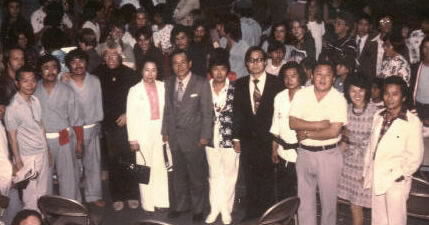 an Hapkido as well. Nowadays, most other martial art names have become generic terms because many of their practitioners have been working only for their own personal individual success. There have been many people that make their own Kwans or Wons, use their own maiden name in front of their martial art name or simply do not have any connection to an identity of a martial art (like Kim's Tae Kwon Do and Hap Ki Do, Joe's Karate, or Kim's martial art academy). These types of mistaken displays damage their traditional martial art identity. This is the reason that our Hwa Rang Do® never gives permission to use the terms "Kwan" or "Won" or even a personal name in connection with the martial art name of Hwa Rang Do ®. A practitioner of any martial art should be working not only for their own individual success, but also for the success and honor of their particular martial art. A martial art is not just a business store front, it is a way of life that involves passing on an honorable identity to the future generations. With this in mind, following the dissolution of the Unified Korean Martial Arts Association, Hwa Rang Do ® Founder Dr. Joo-Bang Lee went to his original ancient secret Hwarang combat skills master Suahm Dosa,and explained the circumstances that had transpired over the past 8 years. After explaining this situation, Dr. Lee finally received permission from Suahm Dosa to teach the Hwarang combat skills to the public with the Hwa Rang Do®
an Hapkido as well. Nowadays, most other martial art names have become generic terms because many of their practitioners have been working only for their own personal individual success. There have been many people that make their own Kwans or Wons, use their own maiden name in front of their martial art name or simply do not have any connection to an identity of a martial art (like Kim's Tae Kwon Do and Hap Ki Do, Joe's Karate, or Kim's martial art academy). These types of mistaken displays damage their traditional martial art identity. This is the reason that our Hwa Rang Do® never gives permission to use the terms "Kwan" or "Won" or even a personal name in connection with the martial art name of Hwa Rang Do ®. A practitioner of any martial art should be working not only for their own individual success, but also for the success and honor of their particular martial art. A martial art is not just a business store front, it is a way of life that involves passing on an honorable identity to the future generations. With this in mind, following the dissolution of the Unified Korean Martial Arts Association, Hwa Rang Do ® Founder Dr. Joo-Bang Lee went to his original ancient secret Hwarang combat skills master Suahm Dosa,and explained the circumstances that had transpired over the past 8 years. After explaining this situation, Dr. Lee finally received permission from Suahm Dosa to teach the Hwarang combat skills to the public with the Hwa Rang Do® 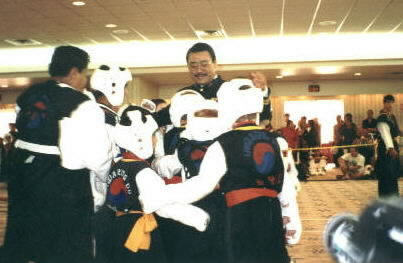 what occurred in Korea when the first Korean martial arts were formed in the 1950`s and 1960's, and also to clear any public misunderstandings. All Korean martial art practitioners from the 1960's know that Dr. Joo-Bang Lee is one of the founders of the Hap Ki Do name and strongly built this martial art during this time. However, from 1968 on, all of his efforts have been dedicated to the single identity of Hwa Rang Do ®.
what occurred in Korea when the first Korean martial arts were formed in the 1950`s and 1960's, and also to clear any public misunderstandings. All Korean martial art practitioners from the 1960's know that Dr. Joo-Bang Lee is one of the founders of the Hap Ki Do name and strongly built this martial art during this time. However, from 1968 on, all of his efforts have been dedicated to the single identity of Hwa Rang Do ®.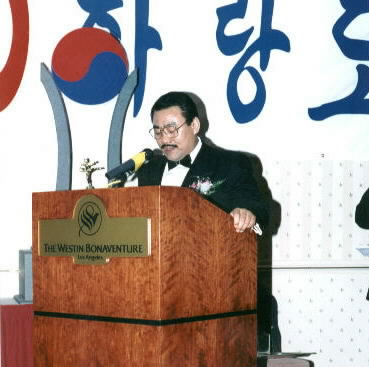 she must also have the ability to heal. Founder Dr. Lee is a licensed doctor of eastern medicine,and an acupuncture specialist and Ki healer. He learned secret techniques from his master Suahm Dosa's healing skills, graduated DongYang University of eastern medicine in Korea, and received his Ph D. from SamRa University of oriental medicine. He insists that all advanced practitioners of Hwa Rang Do ® learn the healing arts as well as the combative aspects. Founder Dr. Joo-Bang Lee is the one who divided and created the categories of Hwa Rang Do ® for public instruction. From the Mu Sool (martial skill) aspects there are the four categories that are NAE GONG {internal power}, WAE GONG {external power}, MOO GI GONG {weapon power}, and SHIN GONG {mental power}. And from the In Sool (healing skill) aspects there are six categories named JI AP SOOL (acupressure), CHIM GU SOOL (acupuncture and maxabustion), YAK BANG BOP (herbal medicine), JUP GOL SOOL (bone setting), HWAL BOP (Special Aids), and KI RYUK SOOL (Ki power healing). Along with these divisions our founder is also teaching the ancient Silla Hwarang's code of ethics and his own philosophies concerning human morality.
she must also have the ability to heal. Founder Dr. Lee is a licensed doctor of eastern medicine,and an acupuncture specialist and Ki healer. He learned secret techniques from his master Suahm Dosa's healing skills, graduated DongYang University of eastern medicine in Korea, and received his Ph D. from SamRa University of oriental medicine. He insists that all advanced practitioners of Hwa Rang Do ® learn the healing arts as well as the combative aspects. Founder Dr. Joo-Bang Lee is the one who divided and created the categories of Hwa Rang Do ® for public instruction. From the Mu Sool (martial skill) aspects there are the four categories that are NAE GONG {internal power}, WAE GONG {external power}, MOO GI GONG {weapon power}, and SHIN GONG {mental power}. And from the In Sool (healing skill) aspects there are six categories named JI AP SOOL (acupressure), CHIM GU SOOL (acupuncture and maxabustion), YAK BANG BOP (herbal medicine), JUP GOL SOOL (bone setting), HWAL BOP (Special Aids), and KI RYUK SOOL (Ki power healing). Along with these divisions our founder is also teaching the ancient Silla Hwarang's code of ethics and his own philosophies concerning human morality.